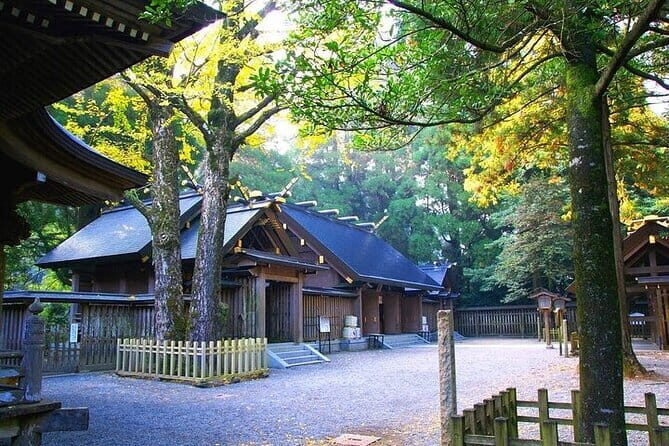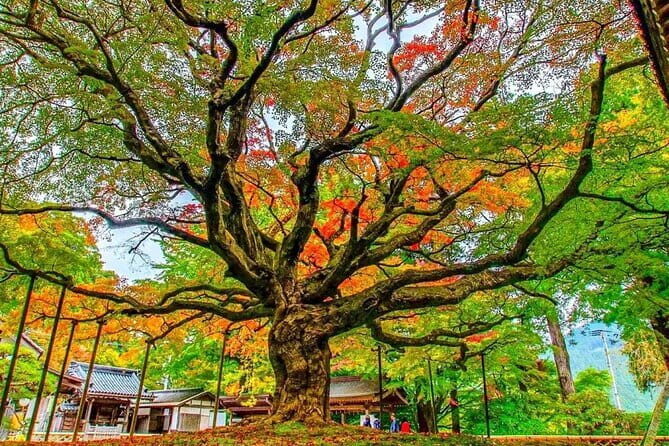When you think of Fukuoka, the image might be of modern cityscapes or bustling markets. But if you want a glimpse into the soul of Hakata, this guided tour offers a carefully curated journey through its most sacred and scenic sites. For $184.95 per person, over roughly seven and a half hours, you’ll visit historic temples, serene gardens, and vibrant shrines—all with a local guide who brings stories and context to each stop. It’s a chance to step away from the urban rush and soak in the spiritual and natural beauty that makes Hakata special.
What we love most about this experience are the opportunities to see Japan’s largest seated wooden Buddha at Tochoji Temple and the peaceful atmosphere of Rakusuien Garden. These spots aren’t just photo ops—they’re places where you can truly feel the quiet power of tradition. Plus, the tour’s focus on authentic locations, away from overly touristy areas, means you get a genuine taste of local culture.
One thing to keep in mind is that the tour involves quite a bit of walking and exploring outside, which might be tiring for those with limited mobility. Still, if you’re reasonably active and appreciate meaningful cultural sites, this tour suits those who want more than just a surface visit. It’s perfect for history buffs, spiritual seekers, or anyone wanting a well-rounded day exploring Hakata’s religious heritage and scenic beauty.
Key Points

- Comprehensive Visit: Combines several temples, shrines, and gardens in one day, showcasing Hakata’s spiritual landscape.
- Authentic Experiences: Focus on historic sites like Shofukuji, Japan’s oldest Zen temple, and the impressive Reclining Buddha at Nanzoin.
- Local Insights: Led by a knowledgeable guide who shares stories and context, enriching the experience.
- Convenient Logistics: Starts at Hakata Station and ends back in the same area, making planning easy.
- Value for Price: For just under $185, you get a full day of guided sightseeing, entry to significant sites, and a traditional lunch.
- Good for Active Travelers: The day involves walking and some stairs, so moderate fitness is recommended.
A Deep Dive into the Hakata Temples and Scenic Sites
Planning more time in Fukuoka? We've covered other experiences worth considering.
Starting Point: Hakata Station and Nanzoin Temple
Your day begins at Hakata Station, a hub of activity and easy to find. From here, the group heads to Nanzoin Temple, which is a hidden gem for those who love striking statues and peaceful surroundings. The highlight? Japan’s largest reclining Buddha, known as Nehanz, measuring a staggering length, with intricate carvings that demand closer inspection.
We loved how the guide explained the significance of this Buddha, providing not just facts but also stories about its construction and spiritual importance. The walk through the temple grounds is calming—you’re surrounded by lush greenery and sacred sites like the Fudo Myo-o statue, which adds a fiery, protective vibe to the atmosphere. The nearby waterfall and Mizuko Jizo statues make for photogenic moments that also pair well with reflections on life and rebirth.
This stop is about 1.5 hours, giving you ample time to explore, photograph, and soak in the tranquility. The interior of the Buddha is accessible if you wish, offering a more intimate spiritual connection. Many visitors find this experience both awe-inspiring and grounding.
Tochoji Temple: Japan’s Oldest Wooden Buddha
Next, your group visits Tochoji Temple, founded in 806 AD, making it one of Japan’s oldest Shingon temples. The Fukuoka Daibutsu here is a true marvel—it’s one of the largest seated wooden Buddha statues in Japan, and it’s as impressive as you might imagine. Its grand stature and serene expression make it a favorite photo spot.
The temple’s red five-story pagoda is also a highlight—photogenic and a classic symbol of Hakata. The tour includes a visit to the “Hell and Paradise” passage, a unique feature that offers a symbolic journey through Buddhist conceptions of the afterlife. It’s a fascinating way to understand the cultural lens through which Japanese spirituality is viewed.
This site provides a deep sense of history and calmness. Many travelers comment on the striking architecture and the peaceful atmosphere that invites meditation or quiet contemplation. Allow about 30 minutes here, but don’t rush—this is a place to savor.
Shofuku-ji Temple: Japan’s Oldest Zen Temple
A short walk brings you to Shofuku-ji, founded in 1195 by Eisai, the monk credited with introducing Zen Buddhism and tea to Japan. Here, the woodwork and traditional gardens evoke a sense of timelessness. The garden and Zen atmosphere make it a perfect spot to slow down and breathe.
Visitors often remark on how this temple’s architecture and grounds reflect a pure, unspoiled Zen aesthetic. The guide shares stories about the monks, Zen practices, and how this temple influenced Japanese culture. It’s a calm, contemplative stop and a contrast to the more prominent Buddha statues earlier in the day.
Sumiyoshi Shrine: An Ancient Shinto Sanctuary
From Zen to Shinto, your next stop is Sumiyoshi Shrine, over 1,800 years old. Its simple, elegant Sumiyoshi-zukuri style building is striking because of its lack of ornamentation—what you see is what you get, and that’s part of its beauty.
The shrine’s peaceful grove, pond, and the sacred Ginkgo tree create a perfect setting for quiet reflection. Visitors can participate in traditional blessings, such as prayers for safe travel—fitting, given Hakata’s historic role as a maritime city. It’s a quick stop, but one that leaves a sense of connection with Japan’s spiritual roots.
- 5-Day ONE WAY Bus to North Hyogo from Fukuoka to Hiroshima
- 3 Day One-way Tour to Osaka From Fukuoka via SANYO with Bus
- 5 Day One Way Bus Trip to Fukuoka from Osaka via San’in
- Challenge Karate Experience
- Day Tour to “Akiyoshi Dai”, Yamaguchi from Fukuoka with Bus
- Day Trip Bus Tour from Fukuoka to Tunoshima, Yamaguchi
Rakusuien Garden: A Quiet Urban Retreat
A hidden treasure within the city, Rakusuien offers a tranquil moment amid its traditional Japanese garden. Built from a merchant’s villa, it features a pond filled with koi, a charming teahouse, and seasonal flowers that change the scene throughout the year.
Many travelers appreciate this quiet oasis, especially those interested in garden design or looking for a peaceful break. You can enjoy a traditional tea ceremony here or simply wander along the paths, soaking in the harmonious landscape.
Kushida Shrine: The Heart of Hakata’s Festival Spirit
Your final stop is Kushida Shrine, famous for hosting the lively Hakata Gion Yamakasa festival. Its history stretches back over 1,200 years, and it remains a hub of local tradition. The shrine’s architecture is elegant, with a sacred gingko tree and a spring that’s believed to have healing properties.
This site offers a lively contrast to the previous quiet gardens. You might see festival floats or witness preparations if your timing aligns with local events. Many visitors find this an uplifting, vibrant place that connects them directly to Hakata’s lively spirit.
Practical Details and What It Means for You

The tour operates on a mobile ticket basis, starting promptly at 9:00 am from Hakata Station. It’s a private tour, so you have the benefit of a dedicated guide—likely someone who can tailor stories and insights to your interests. Expect to walk and explore for most of the day, with moderate physical activity involved, so wear comfortable shoes and prepare for some stairs.
The price includes admission tickets to most sites, making the day straightforward. The lunch is a local treat, offering a taste of Hakata’s culinary culture, though the specifics aren’t detailed here.
You’ll appreciate the group discounts if traveling with others, and the flexibility of cancellation up to 24 hours ahead.
Who Is This Tour Best For?

This tour is ideal for travelers who want a deep cultural experience, blending history, spirituality, and scenic beauty. It suits those with moderate physical fitness, as there’s a fair amount of walking and some uneven terrain. If you’re interested in Japan’s religious traditions—both Buddhist and Shinto—this will provide meaningful insights. It’s also perfect for anyone looking for a relaxed pace with plenty of opportunities to photograph and reflect.
It’s a good fit for history buffs, cultural enthusiasts, or spiritual explorers eager to see Hakata beyond its modern façade. If you prefer a quick overview or have limited mobility, you might find some stops challenging, but overall, it offers a well-balanced introduction to Hakata’s sacred sites.
The Sum Up

This Hakata temple and shrine tour offers a well-rounded, authentic look at the spiritual side of Fukuoka. With visits to iconic sites like the Reclining Buddha at Nanzoin and the ancient Zen temple of Shofuku-ji, it balances history, serenity, and local culture beautifully. The guide’s stories and insights make each location come alive, giving you more than just photos—you leave with a genuine sense of connection and understanding.
For travelers seeking a meaningful day that combines scenic beauty with spiritual depth, this tour provides excellent value. It’s especially suitable for those who enjoy exploring religious sites, gardens, and traditional architecture at a relaxed pace. If you’re after a taste of Hakata’s soul—calm, historic, and inspirational—this tour is a solid choice.
FAQ

What is the starting point of the tour?
It begins at Mister Donut near Hakata Station, making it easy to find and convenient for travelers arriving by train.
How long does the tour last?
The entire experience is approximately 7 hours and 30 minutes, including travel time, site visits, and breaks.
Is lunch included?
Yes, a local lunch is part of the tour, offering a chance to enjoy Hakata’s regional flavors.
Are admission tickets included?
Most sites, including Nanzoin, Tochoji, and Rakusuien, include admission in the tour price. Some sites have free entry, like Shofukuji and Kushida Shrine.
What should I wear?
Comfortable shoes are essential, as there’s quite a bit of walking. Dress for the weather, especially if it’s hot or rainy.
Can I explore the interior of the Reclining Buddha?
Yes, you can explore inside the Buddha for a more personal spiritual experience.
Is this tour suitable for children?
While the focus is on cultural and religious sites, children who enjoy walking and historic sights will find it engaging. Be mindful of the physical demands.
What if I have limited mobility?
The tour involves walking and some stairs, so it’s best suited for those with moderate fitness. Check with the provider if you need specific accommodations.
Can I cancel the tour?
Yes, you can cancel up to 24 hours in advance for a full refund via the booking platform.
This guided exploration of Hakata’s temples, shrines, and scenic treasures offers an enriching, manageable way to connect with Japan’s spiritual heritage. Perfect for those who want to see the city’s sacred sites without the hassle of planning each visit, it promises a day full of meaningful sights and stories.
More Tour Reviews in Fukuoka
- Fukuoka Private Customizable Half Day Tour
- Japan’s Dazaifu,Nanzoin and Mountaintop Full Day Private Tour
- Private Transfer from Fukuoka Airport(FUK) to Fukuoka Cruise Port
- 5-Day One Way Bus Trip to North Hyogo from Fukuoka to Hiroshima
- Japan Fukuoka Tower E Ticket
- Fukuoka Airport to from Fukuoka City Private Taxi Transfers
More Fukuoka experiences we've covered
- Fukuoka Private Customizable Half Day Tour
- Japan’s Dazaifu,Nanzoin and Mountaintop Full Day Private Tour
- Private Transfer from Fukuoka Airport(FUK) to Fukuoka Cruise Port
- 5-Day One Way Bus Trip to North Hyogo from Fukuoka to Hiroshima
- Private Day Tour in Hidden Fukuoka Japan
- FUKUOKA: Sushi Making & Omakase Sushi Experience in Dazaifu
- Japan Fukuoka Tower E Ticket
- Fukuoka Airport to from Fukuoka City Private Taxi Transfers
- Ultimate Sumo Tournament: Tokyo, Osaka, Nagoya, Fukuoka
- Private 9 persons Chartered Bus in Fukuoka
- Fukuoka to Fukuoka Airport (FUK) – Departure Private Transfer
- Hakata Old Town Walking Tour Tracing the True History of Fukuoka
